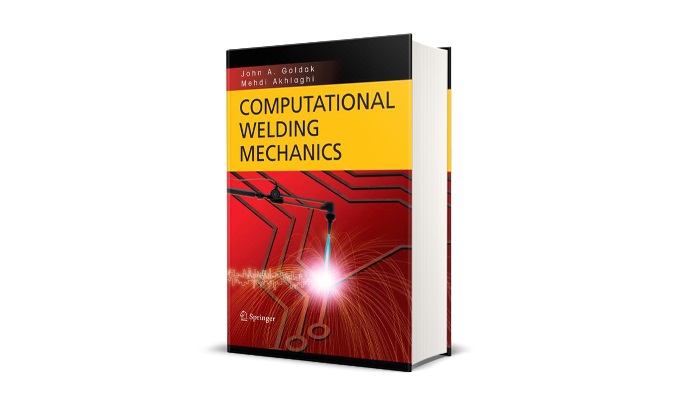Computational welding mechanics

دانلود کتاب Computational welding mechanics
تالیف: John A. Goldak
CWM) Computational Welding Mechanics) به معرفی کامل اصول و کاربردهای جوشکاری محاسباتی می پردازد.
Computational Welding Mechanics روش ها و طراحی های مکانیک جوشکاری محاسباتی را ارائه می دهد.
CWM مناسب برای تمرین مهندسان و دانشجویان مهندسی، مکانیک محاسباتی جوش است.
مکانیک جوشکاری محاسباتی یک زمینه جالب است که در صنایعی مانند صنایع تولید برق، فرآیندهای پتروشیمی، دریا و حمل و نقل هوایی، گرمایش و تهویه مطبوع، نیروی هوایی، منسوجات، لوازم خانگی، و طیف گسترده ای از سیستم های نظامی کاربرد دارد.
فهرست سرفصلهای مهم کتاب:
Chapter I: Introduction
1.1 Introduction and Synopsis
1.2 Brief history of computational welding mechanics
1.3 Mechanical behavior of welds
1.4 Major objective of this book
1.5 References
Chapter II: Computer Simulation of Welding Processes
2.1 Introduction and Synopsis
2.2 The Computing Environment
2.2.1 Computational Geometry
2.2.2 Models for Welding Heat Sources
2.2.3 Kinematic Models for Welding Heat Transfer
2.2.4 Evaluation of the Double Ellipsoid Model
2.2.5 Modeling Thermal Stresses and Distortions in Welds
2.2.6 Microstructure Modeling in Heat Affected Zone (HAZ)
2.2.7 Spatial Integration Schemes
2.3 References
Chapter III: Thermal Analysis of Welds
3.1 Introduction and Synopsis
3.2 Heat Transfer Theory
3.3 Weld Heat Source
3.3.1 Data to characterize a Weld Heat Source
3.3.2 Modeling a Weld Heat Source
3.4 Heat Transfer in Welds
3.4.1 Power Input
3.4.2 Implementation of prescribed temperature model
3.4.3 Starting Transient
3.4.4 Boundary Conditions
3.4.5 Finite Element Solutions with Prescribed Temperature
3.4.6 Computational Results Complex Weld Pool Shape Welds with Filler Metal Addition
3.5 References
Chapter IV: Evolution of Microstructure Depending On Temperature
4.1 Introduction and Synopsis
4.2 Microstructure Model
4.2.1 Data Structures
4.2.2 Test Problems and Results
4.3 Hardness Calculation of the HAZ
4.4 References
Chapter V: Evolution of Microstructure Depending On Deformations
5.1 Introduction and Synopsis
5.2 Properties for Modeling
5.2.1 Stresses, Strains and Deformations
5.2.2 Rate Independent Isotropic Plasticity
5.2.3 Linear Viscous Isotropic Plasticity around melting pt
5.2.4 Rate dependent isotropic plasticity (General case)
5.2.5 Changing Constitutive Equations in Time and Space
5.2.6 Numerical Experiments and Results
5.3 References
Chapter VI: Carburized and Hydrogen Diffusion Analysis
6.1 Introduction and Synopsis
6.2 Carburization; Theory and Numerical Methods
6.2.1 Thermal, Microstructure and Stress Analysis
6.3 Hydrogen Diffusion in Welds
6.3.1 Fundamental Equation
6.3.2 Preheat prediction
6.3.3 Computational Analysis
6.4 References
Chapter VII: Welded Structures and Applications of Welding in Industrial Fields
7.1 Introduction and Synopsis
7.2 Weld Procedure
7.3 Weld Joint
7.4 Analysis of a Weld Structure
7.5 Real-Time for CWM
7.5.1 Current Performance for CWM
7.5.2 Implications of real-time C WM
7.6 References
Chapter VIII: Fracture Mechanics
8.1 Introduction and Synopsis
8.2 Review and Model Development
8.3 Discussion
8.4 References
Chapter IX: Input Data for Computational Welding Mechanics
9.1 Introduction and Synopsis
9.2 Structure to be Welded
9.3 Weld Procedure
9.4 Thermal Analysis Outside the Weld Pool
9.5 Microstructure Evolution
9.6 Thermal Stress Analysis Outside the Weld Pool
9.7 Weld Pool Solver
9.8 Material Properties Summary
9.9 Visualization
9.10 Fracture Mechanics of Welded Structures
- فرمت فایل: pdf
- زبان نگارش: انگلیسی (زبان اصلی)
- تعداد صفحات: 326
- ویرایش: 2005